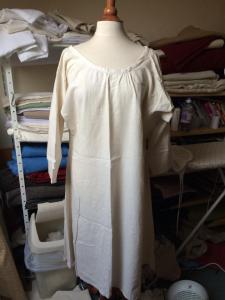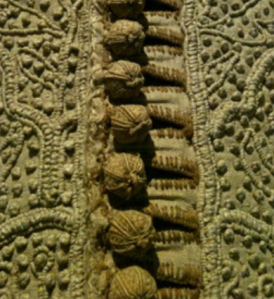 The basic item of underclothing for a woman in the seventeenth century was the the smock, or shift. For a while the two names were synonymous, but by about 1660 the word smock faded out of use as it had become to have shady connotations. Whatever they called it, it was a long T-shaped garment, made of linen with sleeves, reaching down to below the knees. As with most linen garments of our period, the only surviving examples are of the best quality cloth and are highly embroidered. However, it’s probably safe to assume that the pattern was basically the same for everyone, although some portraits suggest that a low neckline would have been worn with lower cut bodices and perhaps with other clothes. It’s tricky to tell what is worn beneath a folded kerchief. The purpose was probably the same too, to protect the outergarments that would tend not to be washed as often from body oils and perspiration.
The basic item of underclothing for a woman in the seventeenth century was the the smock, or shift. For a while the two names were synonymous, but by about 1660 the word smock faded out of use as it had become to have shady connotations. Whatever they called it, it was a long T-shaped garment, made of linen with sleeves, reaching down to below the knees. As with most linen garments of our period, the only surviving examples are of the best quality cloth and are highly embroidered. However, it’s probably safe to assume that the pattern was basically the same for everyone, although some portraits suggest that a low neckline would have been worn with lower cut bodices and perhaps with other clothes. It’s tricky to tell what is worn beneath a folded kerchief. The purpose was probably the same too, to protect the outergarments that would tend not to be washed as often from body oils and perspiration.
Picture left from A Juniper Lecture by John Taylor 1639.
 The extant smocks from the first third of the seventeenth century mostly have a standing collar, a single slit neck opening and long fullsleeves. Sadly there are none exactly datable to the 1640s, but these examples are a good guide to what was worn. This one in the V&A, picture from Drea Leed of Elizabethan Costuming is a nice one dated 1630 with a standard pattern and embroidered over the upper body. Much like a man’s shirt, they would be cut from a standard width of linen, anything from 30 to 36 inches wide. There is usually, like this example, a square gusset under the arms, but unlike a shirt there are either long triangular gores inserted in the sides or a looser cut to make the garment fuller and as such easier to walk around in. The V&A example also has a gusset inserted either side of the collar to provide strength.
The extant smocks from the first third of the seventeenth century mostly have a standing collar, a single slit neck opening and long fullsleeves. Sadly there are none exactly datable to the 1640s, but these examples are a good guide to what was worn. This one in the V&A, picture from Drea Leed of Elizabethan Costuming is a nice one dated 1630 with a standard pattern and embroidered over the upper body. Much like a man’s shirt, they would be cut from a standard width of linen, anything from 30 to 36 inches wide. There is usually, like this example, a square gusset under the arms, but unlike a shirt there are either long triangular gores inserted in the sides or a looser cut to make the garment fuller and as such easier to walk around in. The V&A example also has a gusset inserted either side of the collar to provide strength.
Here are two photos from the Bath Costume Museum showing a shoulder and underarm gusset. This is an early smock too, dated to 1610, but definitely the style still being worn in the 1640s.
A few really high status smocks have lower necklines that are gathered and tightly stitched onto a narrow neck band (not with a drawstring). This clears the neckline for an off the shoulder look, but these are really ornate with acres of fabric requiring such finely detailed needlework that they should be only considered the preserve of someone of serious wealth, not a common serving girl or army follower. All the museum examples have lines of embroidery, very similar to those on surviving men’s shirts which is no surprise really as both garments, in fact anything made of linen, was considered women’s work. The image linked here shows a portrait of a woman wearing a high necked smock
Smocks were worn both day and night. High class people may have had a separate night smock to change into, but it can be safely assumed that most common folk slept in the smock they wore during the day. Detail from Come Buy A Mousetrap. Pamphlet by Humphrey Crouch 1647
These pictures show two plain (in the sense of undecorated) reproduction smocks from 
 the 1642 Tailor. On the right with a high neckline and on the left with a lower, more scooped line for wearing with a low cut bodice.
the 1642 Tailor. On the right with a high neckline and on the left with a lower, more scooped line for wearing with a low cut bodice.
Recommended reading: Janet Arnold Patterns of Fashion 4






































































